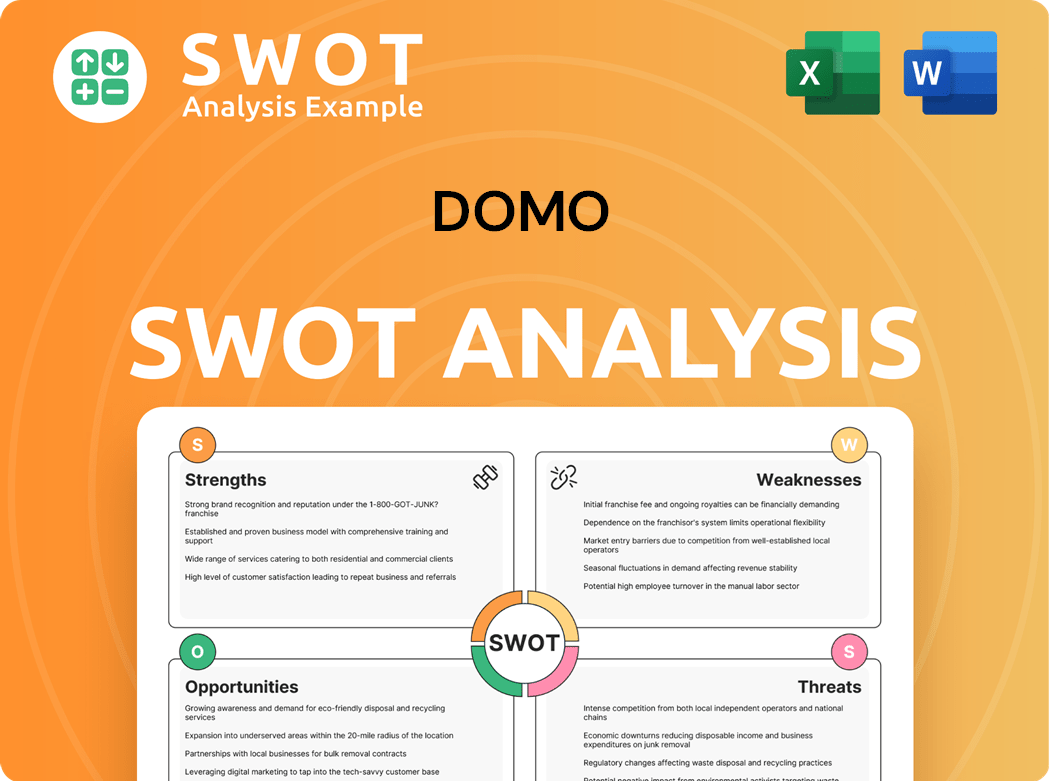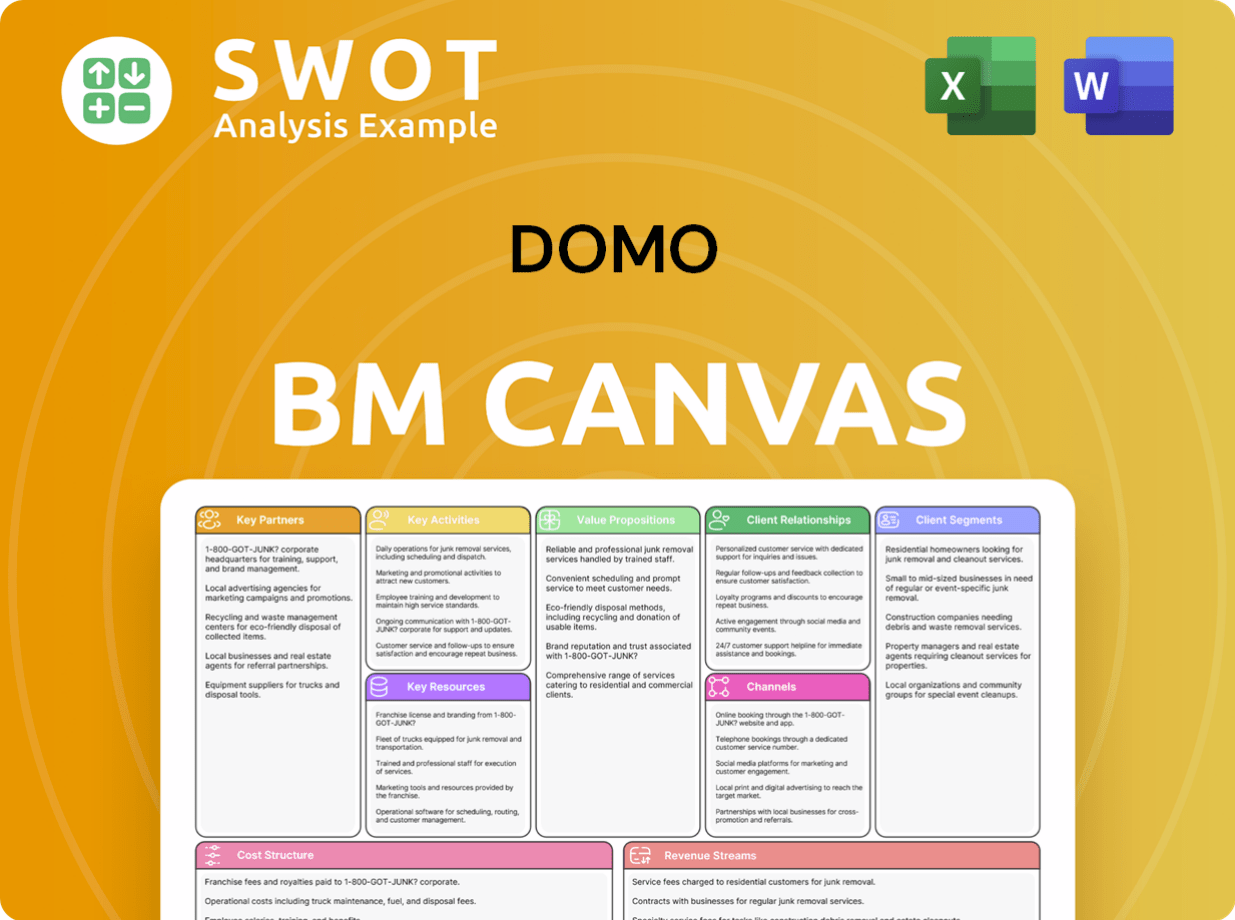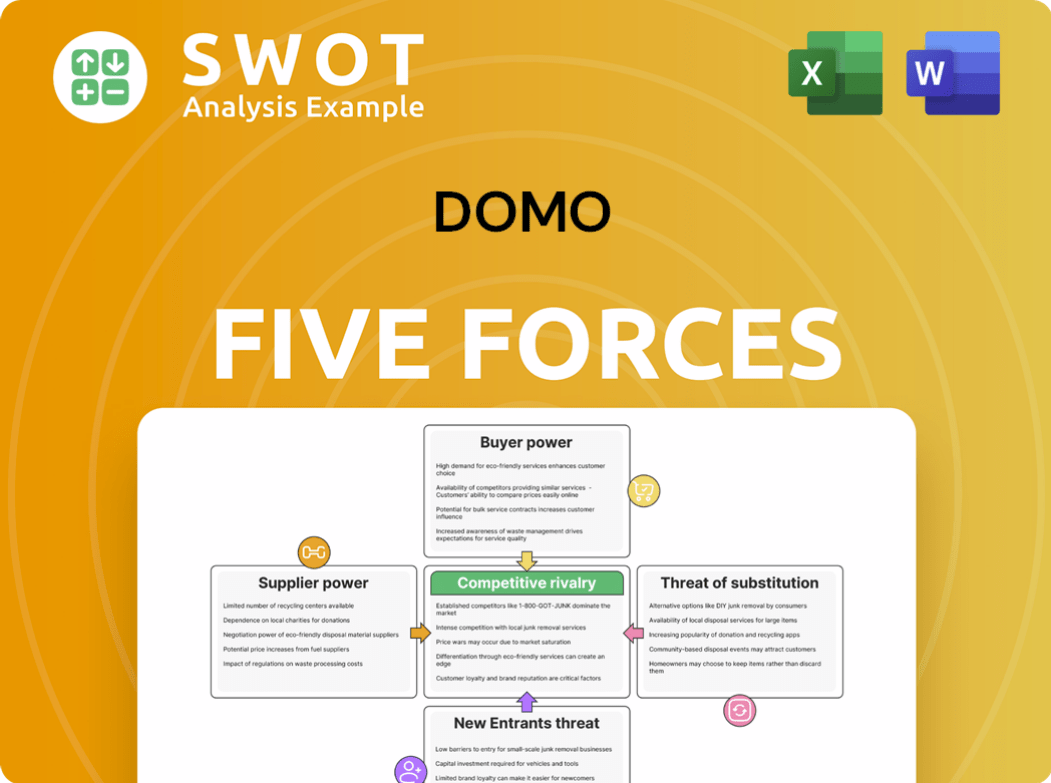DOMO Bundle
Who Does DOMO Serve in the Data-Driven World?
In today's fast-paced business environment, understanding the DOMO SWOT Analysis is essential for strategic success. For the DOMO company, a deep dive into its customer demographics and target market is critical. This analysis is especially important given the dynamic nature of data analytics and the ever-evolving business intelligence landscape.

This exploration will uncover the DOMO company's ideal customers, examining their needs, preferences, and how DOMO tailors its strategies to effectively serve them. We'll delve into the DOMO user demographics by industry, analyze the DOMO customer base size, and explore the DOMO customer acquisition strategy to provide a comprehensive understanding of its market position. Furthermore, we will touch upon DOMO's key customer segments and how they contribute to the overall success of the platform.
Who Are DOMO’s Main Customers?
Understanding the Owners & Shareholders of DOMO involves a close look at its core customer base. The DOMO company primarily focuses on business-to-business (B2B) clients, spanning both small to medium-sized businesses (SMBs) and large enterprises. This focus helps define its target market and shapes its customer demographics.
As of January 31, 2025, the company had over 2,600 customers. This indicates a substantial market presence and a broad reach across various industries. The DOMO company leverages data analytics and business intelligence to serve its clients.
The customer profile typically includes tech-savvy organizations that prioritize data-driven decision-making. This focus allows the company to tailor its offerings to meet the specific needs of its clientele, which is crucial for customer satisfaction and retention.
The company's customer base is diverse, with a significant presence in manufacturing, services, healthcare, and finance. Manufacturing accounts for a substantial 52% of the customer base.
Within these organizations, the primary users of the platform are executives, C-level executives, directors, and managers. These individuals are responsible for making strategic decisions based on data insights.
In fiscal year 2025, enterprise customers contributed $145.0 million to the company's revenue. Corporate customer revenue grew to $172.0 million. This shows a shift towards the mid-market.
The company has moved towards a consumption-based pricing model. Over 68% of its annual recurring revenue (ARR) uses this model, which is expected to boost customer adoption and align pricing with value.
Analyzing the DOMO company customer segmentation reveals a strategic focus on specific sectors and decision-makers. This approach helps the company tailor its marketing strategies for target audiences and improve DOMO's customer satisfaction.
- The DOMO software target market includes businesses that require robust data analytics and business intelligence solutions.
- The company's customer acquisition strategy is likely focused on reaching key decision-makers within these target industries.
- Understanding DOMO's key customer segments is crucial for assessing its competitive positioning and future growth prospects.
- The company's success stories often highlight how it meets DOMO's customer needs analysis.
DOMO SWOT Analysis
- Complete SWOT Breakdown
- Fully Customizable
- Editable in Excel & Word
- Professional Formatting
- Investor-Ready Format

What Do DOMO’s Customers Want?
Customers of the company are driven by the need for actionable insights and data-driven decision-making. They seek a comprehensive platform that can connect to various data sources, centralize information, and provide visualization and analytics tools. This streamlines operations and improves decision-making.
Key purchasing behaviors and decision-making criteria often revolve around ease of use, real-time insights, and the ability to leverage AI and data science for optimizing business processes. Customers also value platforms that allow for self-guided expansion of use and offer robust online support resources. Understanding the customer demographics and target market is crucial for the company's success.
Common pain points addressed by the company include data silos, the need for improved collaboration across organizations, and the challenge of quickly turning raw data into meaningful business outcomes. The company's investment in areas like machine learning, predictive analytics, and other AI technologies directly addresses these evolving needs, influencing product development. For example, recent product innovations are designed to simplify processes and enhance data exploration and analysis.
Customers want a platform that provides actionable insights. This means the ability to quickly understand data and make informed decisions. They need tools that translate raw data into clear, understandable information.
The platform should support data-driven decision-making. Customers want to base their strategies on solid data analysis. This includes features for data visualization and advanced analytics.
Ease of use is a critical factor. The platform should be intuitive and easy to navigate. Customers want to avoid complex systems that require extensive training.
Real-time insights are essential for staying competitive. Customers need up-to-the-minute data to make timely decisions. This includes features for live dashboards and alerts.
Leveraging AI and data science is a key requirement. Customers want to use advanced analytics to optimize business processes. This includes predictive analytics and machine learning capabilities.
Customers value platforms that allow for self-guided expansion. This means the ability to customize and scale the platform to meet evolving needs. They want flexibility and control over their data.
The DOMO company addresses several key customer needs, including data silos and the need for improved collaboration. The company's focus on AI and machine learning directly addresses these evolving needs. The platform helps customers transform raw data into meaningful business outcomes. Understanding DOMO's customer needs analysis is crucial for product development and marketing strategies.
- Data Silos: Customers struggle with data scattered across different systems. The company's platform consolidates data, providing a unified view.
- Improved Collaboration: The platform facilitates collaboration across teams and departments. This enhances decision-making and streamlines workflows.
- Actionable Outcomes: Customers need to quickly translate data into insights. The platform provides tools for data visualization and analysis.
- AI and Machine Learning: The company incorporates AI and machine learning to provide predictive analytics. This helps customers optimize their business processes.
- Real-Time Data: Customers require up-to-the-minute data for timely decisions. The platform offers real-time dashboards and alerts.
The shift to consumption-based contracts also aligns with customer preferences for pricing models that directly correlate with data usage and delivered value. Customer feedback from events like Domopalooza further reinforces the importance of a strategic, broad solution that integrates across multiple departments. For more information, you can read a Brief History of DOMO.
DOMO PESTLE Analysis
- Covers All 6 PESTLE Categories
- No Research Needed – Save Hours of Work
- Built by Experts, Trusted by Consultants
- Instant Download, Ready to Use
- 100% Editable, Fully Customizable

Where does DOMO operate?
The geographical market presence of the data analytics and business intelligence company is global, with a strong emphasis on North America, Europe, and Asia. The company's strategy involves targeting customers worldwide and expanding its presence in key markets across different regions. This approach supports its goal of reaching a broad customer base and increasing its market share.
The United States is the company's most significant market, representing a substantial portion of its revenue. Other key geographies include the United Kingdom and Canada, where the company has a notable customer base. The company also operates in Western Europe, Australia, Japan, and India, indicating a diverse international footprint.
To succeed in these diverse markets, the company focuses on localizing its offerings and expanding its global reach. This strategy includes targeting customers worldwide and aiming to expand its presence in key markets across different regions. The company's approach aims to capitalize on the growing demand for data analytics and business intelligence solutions worldwide.
The United States is the strongest market for the company, accounting for a significant portion of its revenue. In fiscal year 2023, the U.S. contributed 78% of total revenue. This dominance continued, with the U.S. representing 79% in fiscal year 2024 and an estimated 80% in fiscal year 2025. This indicates a strong and growing domestic presence, highlighting the importance of the U.S. market for the company.
Beyond the U.S., the company has a notable presence in several international markets. The United Kingdom accounts for 4.74% of the revenue, while Canada contributes 3.93%. The company also operates in Western Europe, Australia, Japan, and India. These markets are crucial for diversifying its revenue streams and expanding its global footprint, supporting its overall growth strategy.
The company focuses on localizing its offerings to cater to the specific needs of each market. This approach allows the company to better serve its customers and compete effectively in diverse regions. The strategy also involves expanding its global reach, targeting customers worldwide. This dual approach of localization and global expansion is key to its international success.
The company's customer acquisition strategy involves targeting a broad range of industries and company sizes. The company aims to expand its presence in key markets across different regions. The company's customer acquisition strategy is supported by its marketing efforts, as detailed in the Marketing Strategy of DOMO article.
DOMO Business Model Canvas
- Complete 9-Block Business Model Canvas
- Effortlessly Communicate Your Business Strategy
- Investor-Ready BMC Format
- 100% Editable and Customizable
- Clear and Structured Layout

How Does DOMO Win & Keep Customers?
The primary strategy for customer acquisition and retention at the [Company Name] is a 'land, expand, and retain' model. This approach focuses on initially securing new customers and then increasing their use of the platform over time. As of January 31, 2025, the company had over 2,600 customers, illustrating the scale of its customer base.
For customer acquisition, the company plans to expand its partner ecosystem, forming agreements with software resellers and system integrators. Marketing efforts include the company's website, press releases, SEC filings, blogs, and social media platforms such as Facebook, LinkedIn, and X (formerly Twitter). These channels are used to disseminate information about the company and its products. Understanding the Growth Strategy of DOMO helps in analyzing the effectiveness of these efforts.
Retention strategies are crucial for the company's performance, focusing on encouraging platform usage among existing customers. The company invests in platform capabilities and online support to facilitate this expansion. The gross retention rate for the 12 months ended January 31, 2025, was 85%, a slight decrease from 89% in 2023 and 86% in 2024, which was partially due to macroeconomic conditions and challenging renewals from customers with COVID-19 use cases.
The company's focus on retention is evident in its strategies and performance metrics. The annual recurring revenue (ARR) net retention rate declined from 100% to 91% over the same period, indicating a need for enhanced retention efforts. However, the shift to consumption-based contracts is expected to improve retention.
- Over 30% of the total ARR is now on a consumption-based model, with a goal of over 50% by the end of the year.
- Consumption renewals in Q1 showed significantly higher gross and net retention rates (96% and greater than 115% respectively) compared to seat-based customers.
- Approximately two-thirds of its customers are under multi-year contracts, which also benefits retention.
DOMO Porter's Five Forces Analysis
- Covers All 5 Competitive Forces in Detail
- Structured for Consultants, Students, and Founders
- 100% Editable in Microsoft Word & Excel
- Instant Digital Download – Use Immediately
- Compatible with Mac & PC – Fully Unlocked

Related Blogs
- What are Mission Vision & Core Values of DOMO Company?
- What is Competitive Landscape of DOMO Company?
- What is Growth Strategy and Future Prospects of DOMO Company?
- How Does DOMO Company Work?
- What is Sales and Marketing Strategy of DOMO Company?
- What is Brief History of DOMO Company?
- Who Owns DOMO Company?
Disclaimer
All information, articles, and product details provided on this website are for general informational and educational purposes only. We do not claim any ownership over, nor do we intend to infringe upon, any trademarks, copyrights, logos, brand names, or other intellectual property mentioned or depicted on this site. Such intellectual property remains the property of its respective owners, and any references here are made solely for identification or informational purposes, without implying any affiliation, endorsement, or partnership.
We make no representations or warranties, express or implied, regarding the accuracy, completeness, or suitability of any content or products presented. Nothing on this website should be construed as legal, tax, investment, financial, medical, or other professional advice. In addition, no part of this site—including articles or product references—constitutes a solicitation, recommendation, endorsement, advertisement, or offer to buy or sell any securities, franchises, or other financial instruments, particularly in jurisdictions where such activity would be unlawful.
All content is of a general nature and may not address the specific circumstances of any individual or entity. It is not a substitute for professional advice or services. Any actions you take based on the information provided here are strictly at your own risk. You accept full responsibility for any decisions or outcomes arising from your use of this website and agree to release us from any liability in connection with your use of, or reliance upon, the content or products found herein.